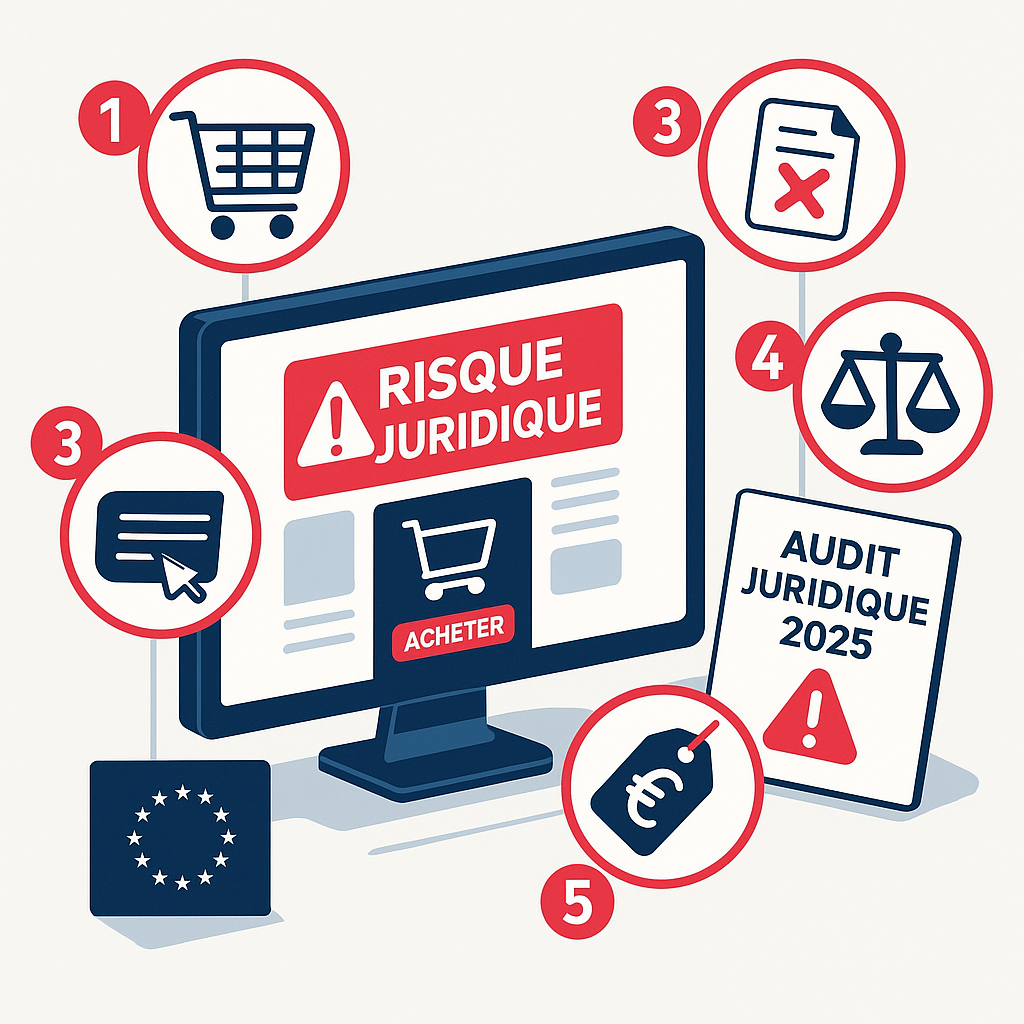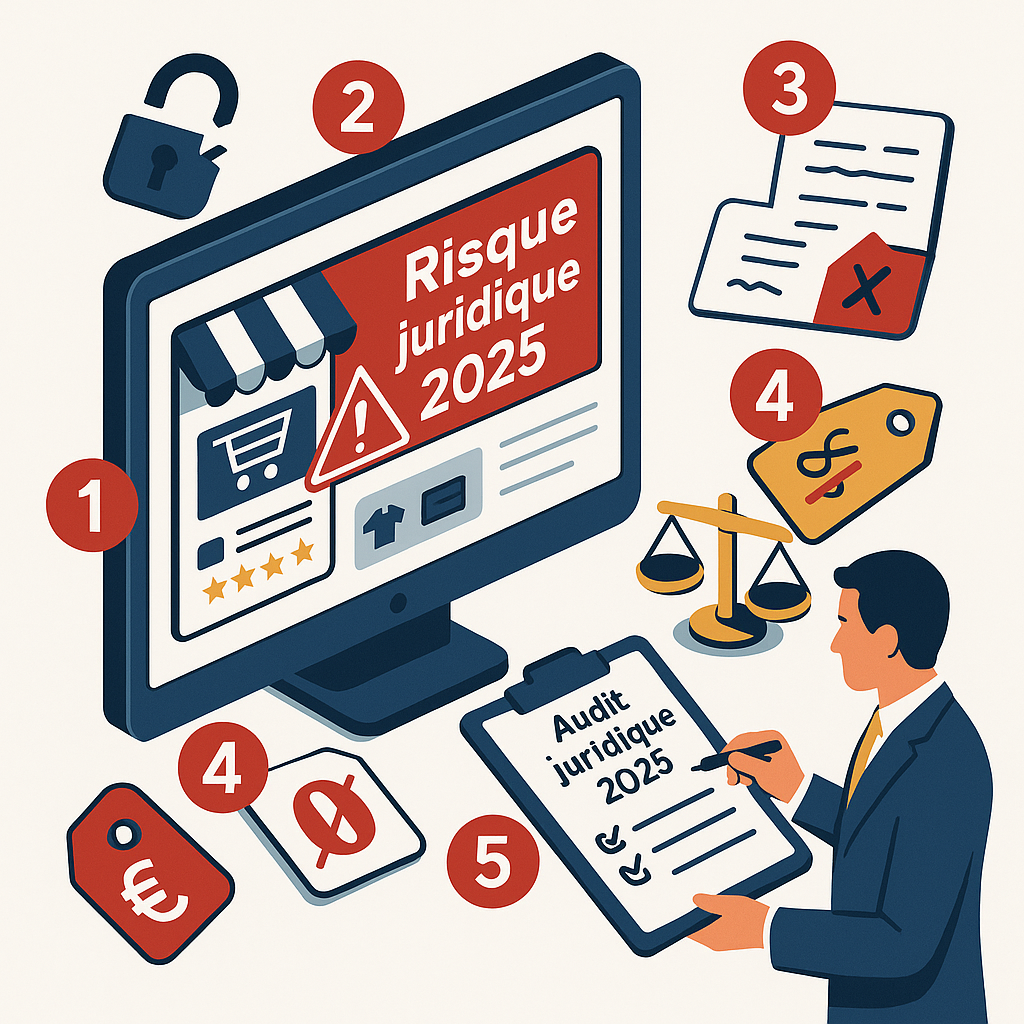E-commerce is growing by leaps and bounds, but its legal framework is becoming increasingly complex. Discover 5 legal risks to be aware of in 2025.
The world of e-commerce is growing by leaps and bounds, but with this expansion comes an increasingly complex legal framework.
In 2025, regulations surrounding online sales have tightened considerably, exposing e-tailers to substantial legal risks.
Understanding these risks is the first step towards effective protection.
If you're looking for an e-commerce lawyer, contact me!
Tougher RGPD penalties: a major financial challenge
Personal data protection has become a top priority for regulatory authorities. Penalties for non-compliance with the RGPD have seen spectacular inflation in recent years. A simple failure to manage consents or secure customer data can now result in fines of up to 4% of global sales.
Checks have intensified, with a particular focus on e-commerce sites which, by their very nature, collect large quantities of data. The handling of cookies, registration forms, purchase histories and payment processes are all points of vigilance scrutinized by the authorities. This year, several medium-sized retailers have been subject to significant sanctions for failing to secure banking information or for non-compliant profiling systems.
Implementing a rigorous privacy policy and a consent management system that complies with the latest regulatory requirements requires in-depth legal expertise. Consulting an e-commerce lawyer allows you to benefit from tailored support to identify potential loopholes and implement solutions tailored to your specific business model. An in-depth RGPD audit, followed by a detailed action plan, is often the first step in this preventive approach.
Consumer disputes: a risk amplified by new European directives
Disputes with customers represent a major source of legal risk for e-tailers. The European Omnibus Directive, now fully in force, has considerably strengthened consumer rights, and consequently widened the scope of potential disputes. Unfair commercial practices are now severely penalized, with penalties of up to 4% of sales.
A simple delivery delay that has not been communicated, a misleading promotion or an unjustified refusal of a refund can quickly degenerate into costly litigation. Advertised delivery times are now considered firm contractual commitments, and failure to meet them can result in cancellation of the order and payment of damages. E-tailers also have to deal with the problem of falsified or manipulated customer reviews, a practice expressly forbidden and punishable by law.
The proliferation of mediation and dispute resolution platforms has also facilitated consumer recourse, mechanically increasing the number of proceedings brought against e-tailers. Consumer associations, increasingly vigilant regarding e-commerce practices, no longer hesitate to take collective action against sites with recurring irregularities, considerably amplifying the financial and reputational consequences of breaches.
The dangers of incomplete or erroneous legal notices
The legal disclaimer on an e-commerce site is more than just an administrative formality. They are a legal obligation, and failure to comply can have serious consequences. Failure to include compulsory information such as full company details, RCS number or details of the hosting company can result in a fine of €75,000 for legal entities.
This obligation has been further strengthened by new regulatory requirements. E-tailers are now required to include precise information in their legal disclosures on dispute resolution procedures, professional certifications and recourse to the consumer ombudsman. The omission of this information not only constitutes a criminal offence, but can also be qualified as a misleading commercial practice by omission.
In addition to financial penalties, incomplete legal disclosures can leave a company legally vulnerable in the event of a dispute, and can be interpreted as a deliberate attempt to conceal information from consumers. This negative perception can seriously compromise the outcome of legal proceedings. The courts generally consider that an e-tailer's professionalism is demonstrated first and foremost by scrupulous compliance with these fundamental information obligations.
Legal notices must also be easily accessible from any page on the site, usually via a link in the footer. The ergonomics of the site must enable the consumer to access this information without difficulty, otherwise its validity will be challenged in the event of a dispute.
General terms and conditions of sale: a fundamental legal document often overlooked
The General Terms and Conditions of Sale (GTCS ) are the contract that binds e-tailers to their customers. All too often regarded as a simple copy-and-paste document, they represent a major legal challenge. Poorly drafted, ambiguous or incomplete general terms and conditions expose the e-merchant to multiple risks: the nullity of certain clauses, the impossibility of asserting rights in the event of litigation, or an interpretation systematically favorable to the consumer in the event of ambiguity.
Recent legislative changes concerning, in particular, the right of withdrawal, legal warranties and delivery terms have rendered obsolete many of the terms and conditions used by e-tailers. The legal guarantee of conformity has been extended to 24 months, and a new durability guarantee has been introduced for certain electronic products and household appliances. These changes must be included in updated GTCs, otherwise consumers will be misled as to their rights.
The courts also pay particular attention to the presentation of GTCs and the acceptance process. Abusive clauses are systematically rejected, and failure to highlight important clauses can lead to their unenforceability. Double-click acceptance and permanent access to archived GTCs have become unavoidable standards.
Regular revision of this document by an experienced legal expert is essential to guarantee its validity and effectiveness. General terms and conditions of sale must be adapted to the e-merchant's specific activity, commercial policy and the particularities of its products or services. A generic document will invariably contain loopholes that will prove detrimental in the event of litigation.
Protecting intellectual property in the digital age
Intellectual property is a strategic asset for any e-commerce business, but its protection is often overlooked. The risk of counterfeiting has increased considerably with the proliferation of marketplaces and the ease with which digital content can be reproduced. Images, product descriptions, logos and other graphic elements are frequently copied without authorization.
Unregistered trademarks are a major vulnerability. Without official registration, an e-tailer runs the risk of seeing his trademark used by competitors, or even registered by a malicious third party. Although trademark registration represents an initial investment, it offers essential legal protection and effective means of action against counterfeiters. The registration strategy must be carefully designed to cover the relevant product classes and the territories where the business is developing.
Domain names are also a crucial issue. Lack of vigilance can lead to cybersquatting, the practice of a third party registering domain names similar to your brand in order to divert your customers or force you to buy them back at a premium price. One way of protecting your brand is to register the main extensions and the most common spelling variants in advance.
Conversely, unauthorized use of images found on the Internet exposes the e-tailer to prosecution for copyright infringement. Penalties can be severe: up to €300,000 in fines and 3 years' imprisonment for counterfeiting, not to mention the damages that may be claimed by rights holders. The emergence of companies specializing in the automated detection of copyright infringement has multiplied the risk of prosecution.
Implementing a strategy to protect and monitor intangible assets has become essential for any e-merchant wishing to perpetuate their business. This strategy must include not only trademark and domain name registration, but also rigorous contractualization with service providers involved in the creation of original content (photographers, copywriters, developers) to ensure full transfer of exploitation rights.
Anticipate rather than suffer: a strategic approach to legal risk
Faced with increasing legal risks and tougher penalties, e-tailers need to take a proactive approach. The growing complexity of the regulatory framework makes it illusory to think you can manage all the legal aspects of an e-commerce business on your own. Investing in appropriate legal support is no longer a luxury, but an economic necessity.
Anticipating risks begins with a complete diagnosis of the company's legal situation. This diagnosis must cover all the dimensions mentioned: data protection, compliance of contractual documents, securing intellectual property, and compliance with information obligations. It helps identify vulnerabilities and prioritize corrective actions.
Beyond simple compliance, it is the company's entire strategy that must integrate the legal dimension as a factor of competitiveness and sustainability. E-tailers who know how to transform this constraint into an opportunity will benefit from a decisive competitive advantage in a market where consumer confidence has become the most precious resource. Legal certainty is now a differentiating factor that plays an integral part in building a strong brand and lasting customer relationships.




